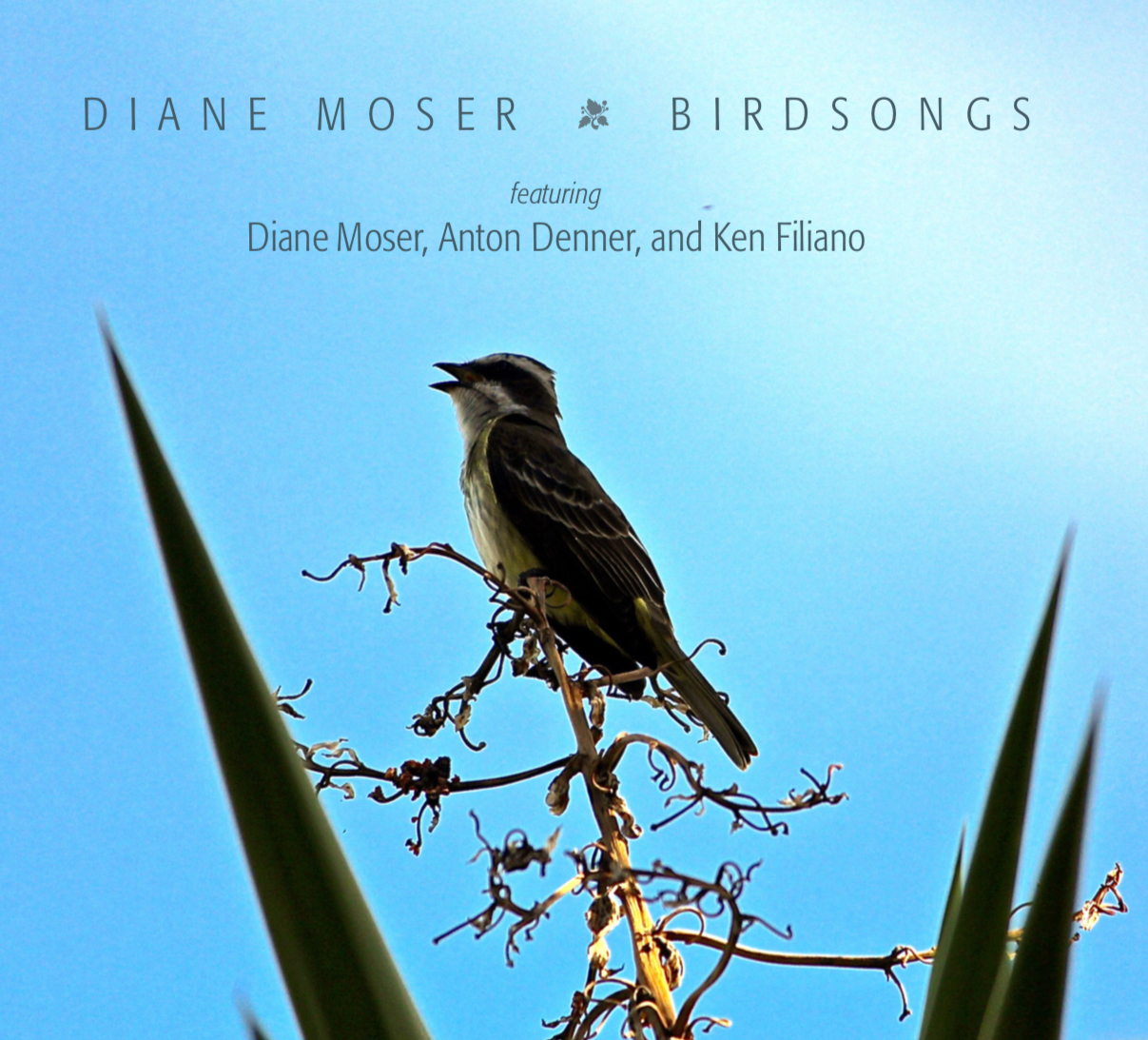My Journey with Bird Songs
By Diane Moser
For the past 11 years, I have been working on incorporating bird songs into my music. When I say “my music”, I am talking about my improvisations, because all of the music I compose starts with improvisation, which I then sculpt into compositions. To me, this is a more “natural“ way to go, but then again, that’s been my approach my entire life. When the composition is set, I leave space for improvisations based on the bird songs, as well as motifs created from the surrounding soundscape. Six of my bird song compositions that are currently in my repertoire were originally created back in 2008 during a 5-week residency at The MacDowell Colony in Peterborough, New Hampshire.
The proposal I submitted for that residency had been to create a series of compositions for an improvisational duo with bassist Mark Dresser, for a recording session scheduled for late July. I also planned to work on a side project, which was a large work for my big band based on Pythagoras’s and Johannes Kepler’s “Music of the Spheres” concept. I brought two suitcases full of books for research to the colony. But when I opened one of my suitcases, a book I had recently bought, David Rothenberg’s Why Birds Sing, fell out of the suitcase. I didn’t remember packing that book! I also brought a book of Amy Beach’s piano music. That I did remember packing because she was an integral part of the success of the MacDowell Colony. I also had a small manuscript book in that suitcase, and for another unknown reason, out fell the letter I had received 11 years earlier, from Adrienne Fried Block, who at that time was writing Amy Beach, Passionate Victorian: The Life and Work of an American Composer, 1867-1944. You would think I would have paid attention to all of these signs from the universe, but no, I initially decided to stay the course with the Spheres side project. That only lasted a day. I was completely seduced by the bird songs around my studio and decided to play around with them for just one afternoon, then get back to work. One afternoon turned into the entire residency; I just had to play with those birds! When would I ever get another chance like this, to have a piano in the middle of the woods, and to play freely? Instead of reading about Kepler, I read David Rothenberg’s book every day, and went to the local bookstore to find Donald Kroodsma’s book with recorded bird songs, The Backyard Birdsong Guide and an illustrated copy of The Music of Wild Birds adapted from The Field Book of Wild Birds and Their Music by F. Schuyler Matthews, who wrote that book in 1904, in Campton, New Hampshire, less than 2 hours from the MacDowell Colony.
My designated studio was Delta Omicron, and inside was a beautiful Mason and Hamlin grand piano. I had a digital recorder and was able to put the microphone in a small window, covering it with a curtain to have a little separation from the piano, which enabled me to hear the birds clearly through my headphones. In this way I was able to adjust the volume I played on the piano so that the birds and I were balanced. I never saw them, so I was never sure who was singing what.
Every day for five weeks, I improvised with songbirds and any other creatures that made their voices heard, and recorded each session. My goal was to become a member of their band, so to speak. I listened deeply to their singing, and carefully infiltrated their ensemble. They, in turn, sang to me and with me and seemed to be okay that I was not only privy to their conversations, but would take part in them as well. We had a standing jam session time at around 10 a.m. each morning until lunch. Then they would retreat, and I would do some reading and listen to our recordings. They would come back out to sing with me around 4 p.m. until I left them for a swim in the local pond. There was also the after-dinner bird ensemble, and we would make music together, but not for long, as they had other business to attend to. In the evenings, I would listen to our recordings of the day, and make notes on the improvisations that would become compositions that I could play again and also perform with other musicians. As I listened, I made marks in the editing track and would decide on what to keep, sometimes switching sections around, but for the most part only editing what I considered “meandering” type improvisations as opposed to fully formed compositions through improvisation.
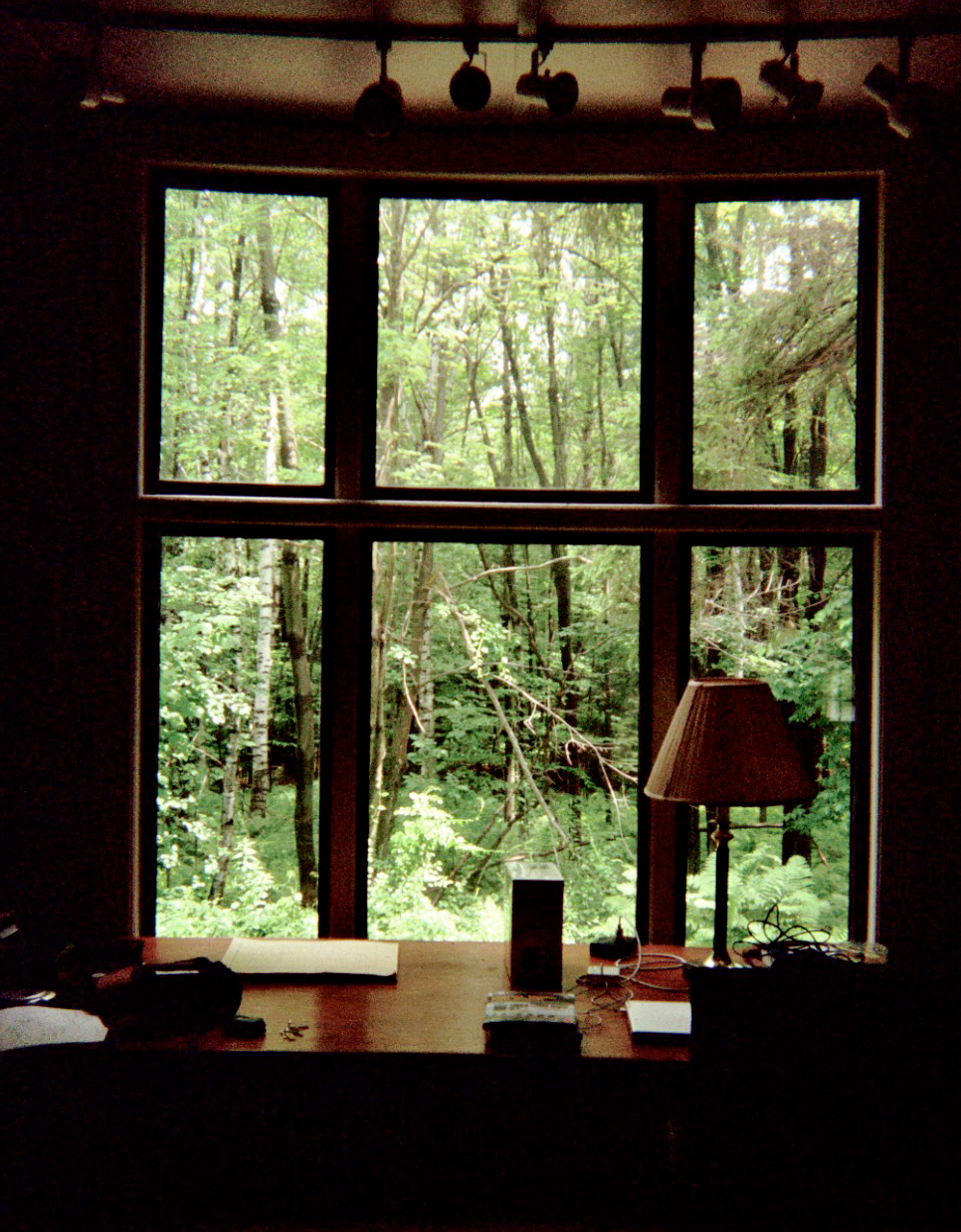
The view from the window.
The first bird I began improvising with was the American Robin. In fact, the most well known song, Cheerily, Cheerily, seemed to creep into all of my improvisations. I slowed down the song just a bit, and lengthened the motif, and played around with it in garage band.
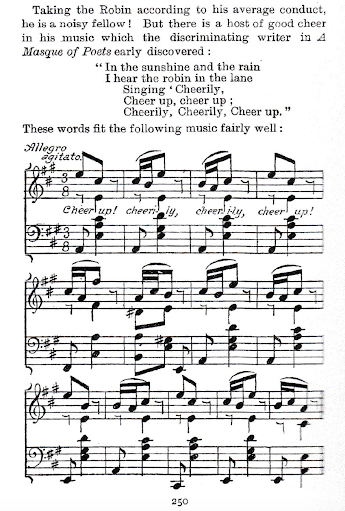
A page from The Field Book of Wild Birds and Their Music by F. Schuyler Mathews featuring Mathews transcription of the robin’s song set to music.
Over time, my improvisations on this theme became a singular line composition, much like the style of early Ornette Coleman, that I freely improvised. I gave it the title “If You Call Me, Then I’ll Call You” and dedicated it to Mark Dresser. The title rhythmically matches the first two measures, and it also represents what the robins use their songs for, calling each other, and what Mark and I have been doing for over forty years, calling each other.
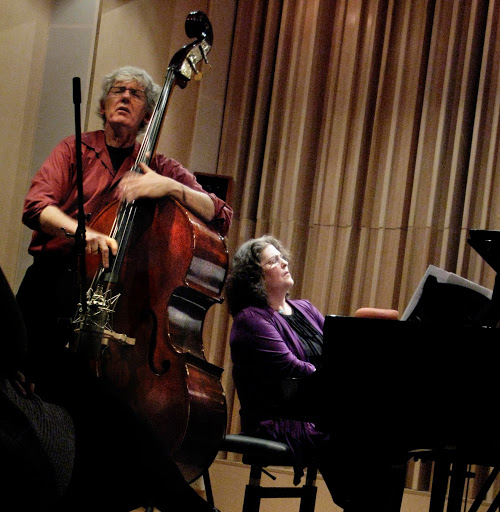
Mark Dresser (bass) and Diane Moser (piano) at Klavierhaus (Photo by Dennis Connors).
Just before sunrise, the first bird I heard singing was the Hermit Thrush. The landscapers at MacDowell referred to the hermit thrush as a deep woods singer, and told me it was the first one singing at the break of day, and first one back into the woods just before sunset. Commonly known as the Nightingale of the Americas, this bird has an amazing set of songs and calls. It’s no wonder that Amy Beach composed two piano pieces based on these songs, one for the morning and one for the evening. She also had perfect pitch and could sit in the woods for hours transcribing bird songs. I have been playing her composition A Hermit Thrush at Eve for years, adding improvisation over her harmonic progression and using hermit thrush songs as a point of departure for improvisation. I have added my version below. Before you listen to the recording, check out the songs of the hermit thrush, and you’ll understand the brilliance of Amy Beach.
After hearing the hermit thrush and the american robin, the next two birds I would hear in the morning were the Black-Capped Chickadee, and the Chipping Sparrow. The Black-Capped Chickadee has a two note song and several calls, but it was the two note song that I was responding to, and the bird responded back with the same two notes. The chipping sparrow has two songs and several calls. The songs are long dry trills, one being faster than the other. I was hearing the faster one and he alternated his song with the black-capped chickadee. I began imitating both of them, improvising in between their songs and my imitations.
Here’s a recording of one of our sessions, right at the very beginning.
As I continued improvising, I integrated both of their songs into a bass line, and then began developing a melody with the two note song from the black-capped chickadee.
All of these improvisations went on for many hours, and other birds would join us for a moment or two.
Originally I had titled the improvisations “Me and the Chickadees”, but I changed it to “Hello” after reading about how bird songs have been set to mnemonics, using a syllabic rhythmic phrase. I decided that the two note song of the black-capped chickadee, a bird song I heard every morning, should quite obviously be called “Hello”.
The bird I had the most fun with was the chipping sparrow. His dry trill and constant singing at regular intervals of time provided tempo and an ostinato for my improvisations. I used the age old technique of a repetitive note as an imitation of the chipping sparrows dry trill, and that became a “thread” for the composition, tying it together. Everything else evolved through improvisation. Think Chopin’s Raindrop Prelude, or any number of compositions. “One Note Samba” by Antonio Carlos Jobim is another good example. As you listen to the recording below, you’ll hear the chipping sparrow, and a dark-eyed junco in the background who wanted to join in with us.
After editing the recordings, I began the tedious process of transcribing. For some pieces I transcribed note for note exactly what I had played. For others, I kept melodies, harmonies, bass lines, and motifs, using them as a jumping-off point for improvisation. I was able to transcribe two of my bird song compositions “Hello” and “If You’ll Call Me, Then I’ll Call You” before I left the MacDowell Colony. We recorded them on my return to New Jersey, during that aforementioned recording session with bassist Mark Dresser and a few days later we performed them live in New York City at The Stone. (Our recording, Duetto, was released in 2012.)
One of the benefits of being a performer-composer are the ensembles that I lead, and other people’s ensembles that I perform with, where I can arrange the music I compose for any combination of instruments. Throughout these performances, I constantly referred back to my original recordings, making sure I was staying true to what the birds and I had created, and especially to the surrounding soundscape which was the palette for the compositions. I also created more space in the notated score for improvisation, but with the caveat that the improvisations needed to reflect the bird songs and the motifs. Thankfully, the musicians I performed with had a wide range of musical experiences and could untether themselves from the standard go-to licks, as we say in the jazz world.
I took a different approach for my next bird song composition, Birdsongs for Eric, a 20-minute suite for septet, based on the flute improvisations of the iconic jazz musician and composer, Eric Dolphy, commissioned for the “Eric Dolphy: Freedom of Sound Celebration Series”.
In 1962, Eric Dolphy told Downbeat magazine interviewer Don DeMichael, “At home [in California] I used to play, and the birds always used to whistle with me. I would stop what I was working on and play with the birds.” I can totally relate to that quote! Happens to me all of the time. The quote and Dolphy’s music inspired me to try a different type of process. With the help of the Cornell Lab of Ornithology’s eBird site and their online Macaulay Library, I was able to study the birds in the area of Los Angeles where Dolphy grew up. I compared those bird songs with as many recordings of Dolphy that I could find and discovered that in virtually every solo he took, not to mention melodies he wrote, there were bird songs or motifs that clearly represented bird songs. I improvised with those bird songs for a bit, then chose the songs I wanted to incorporate into the composition and gave instructions to the musicians to base their improvisations on those motifs.
After all of this experimenting, I formed what I now call the Birdsong Trio, piano, bass and flute. We worked on the music for several years, performing here and there, and in 2016 I decided it was time to do a recording. I commissioned a graduate student that I was mentoring at the Vermont College of Fine Arts, Kyle Pederson, a very talented composer, to compose a piece for this new recording. Kyle, who is from Minnesota, chose the song and calls of his state bird, the common loon, and titled his piece “The (Un)Common Loon”.
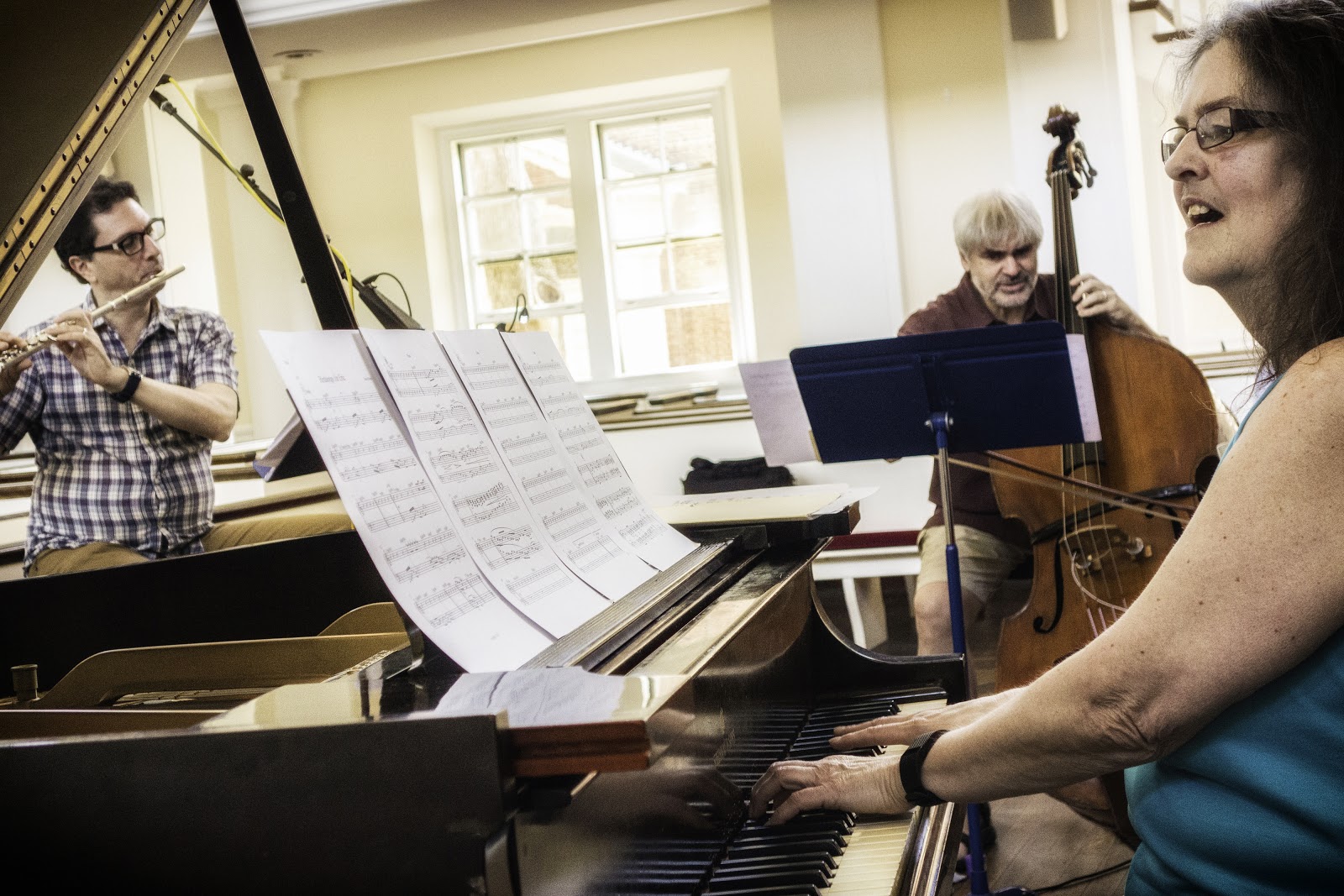
The recording session for the Diane Moser Birdsong Trio (Anton Denner, Ken Filiano, and Diane Moser) at Union Congregational Church in Montclair, New Jersey (Photo by Dennis Connors)
The result of these efforts was the release of Diane Moser: Birdsongs (Planet Arts Records), and little did I know the resounding effect this would have on critics, music fans, and students. We have had truly wonderful reviews from jazz, contemporary fusion, classical and rock music publications, and even a heavy metal blog! Evidence of the universality of not only music, but of bird song.
What has intrigued me about the reviews, is that not only are the reviewers understanding the music, but they are also talking about their own memories of listening to birds, the joyfulness of the music, and how it makes them feel relaxed. When we play our concerts, I begin with a short Deep Listening session with the audience, settling in, closing their eyes, thinking about their favorite birds, thinking about their favorite bird songs, and then I invite them to vocalize their favorite bird songs. I also tell them that they can continue the vocalization for as long as they want. As the audience is vocalizing, our trio improvises with them, and at some point we segue into Birdsongs for Eric. At the end of our concerts audience members have told me they felt transformed, that they were listening differently, that they heard the music in a way they never heard before, and that they felt completely at peace. They often tell me about their bird hikes, show me photos, discuss articles they have recently read and so forth. To this day, I receive emails, postcards, photos, text messages, Facebook posts, and messages from my audience base about their experiences with birds and walking in the woods.
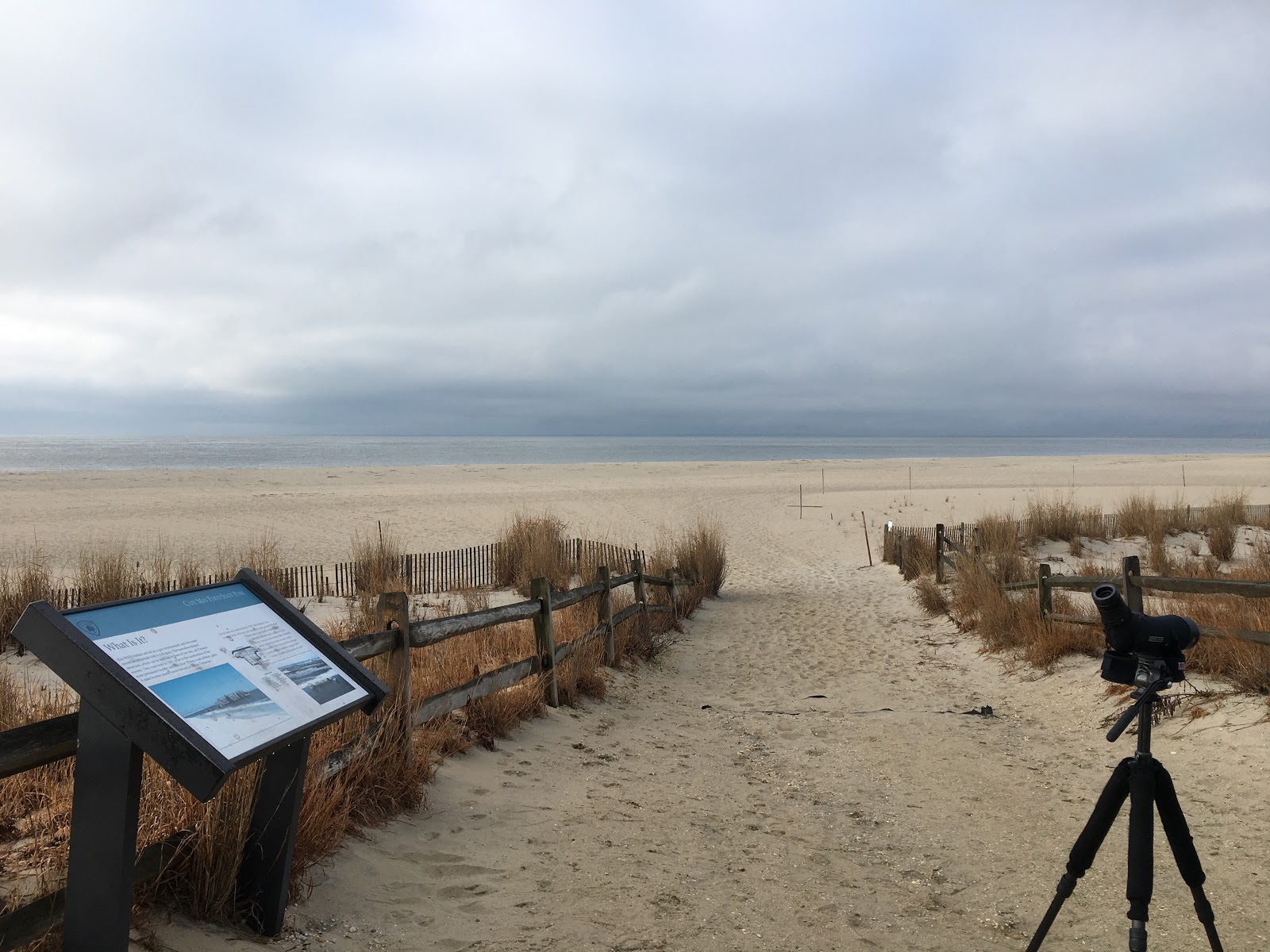
Cape May Point State Park in Cape May,NJ
Recently I received a Faculty Research Grant from The New School for my new project called “Waterbirds: Environmental Dialogues Through Music”, which will include the creation of a 50-minute music composition for my Birdsong Trio, incorporating field recordings that focus on coastal and wetlands birds and their disappearing habitats in and around New Jersey and New York. This is a different approach for me towards creating music, but I am thoroughly enjoying it! Thus far, this project has me traveling the coast of New Jersey, making field recordings and going on bird hikes with the Bergen County Audubon Society, the Cape May Bird Observatory, and New Jersey Audubon. I was granted a research permit from the United States Department of the Interior to work with the National Park Service, and the U.S. Fish and Wildlife Service at Sandy Hook Gateway National Recreation Area in Highlands, N.J., where I spend lots of time. I’m amazed by the work that the Audubon groups, NPS, and US Fish and Wildlife Service are achieving on environmental clean-up, bird and bat habitats, education, land management, and so much more. I love the field-recording process and have already worked on one soundscape composition with my Birdsong Trio, which also includes a film. In part two of this series, I’ll share the film and other journeys I have made with bird songs.
